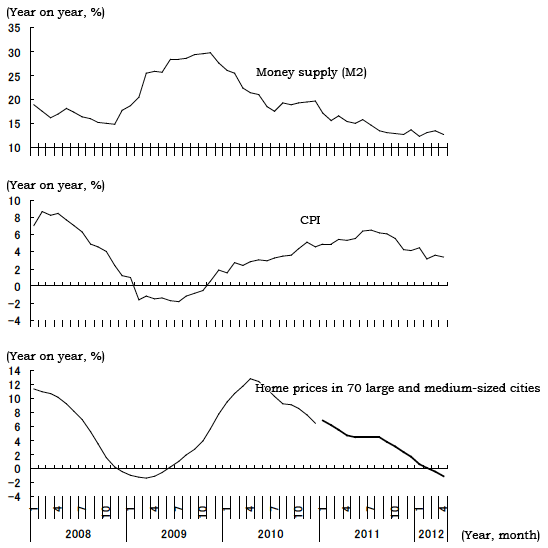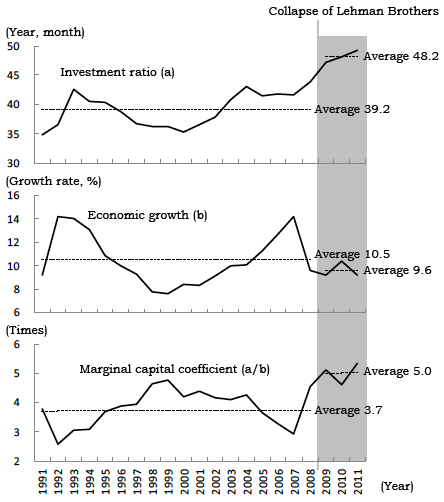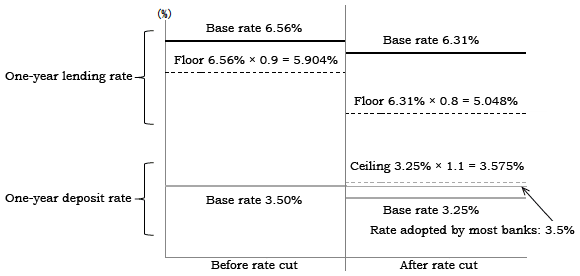The Chinese economy is facing a double whammy of sluggish demand due to falling exports in the short term and a decline in the potential growth rate due to the shift from an excess to a shortage of labor in the medium and long term. Although the implementation of macro policies centering on expansionary fiscal and monetary policies is useful for economic recovery, it also has the significant side effect of leading to inflation and a ballooning real estate bubble, as indicated by the experience after the collapse of Lehman Brothers. In particular, certain investments made in the name of economic stimulus have become difficult to recoup because of their low profitability. Meanwhile, structural reforms, although effective in boosting the potential growth rate, have not had a substantial immediate effect. The Chinese government has to steer its economy between a balance of economic stimulus measures and structural reforms. In fact, in the measures it launched in May 2012 to turn the economy around, the government has started paying attention to structural reforms such as deregulating interest rates, promoting private investments, stimulating consumption, and working toward industrial advances.
The merits and drawbacks of the economic stimulus measures after the global financial crisis
Although China was forced to watch its exports decline significantly and its economy slow down after the collapse of Lehman Brothers in September 2008, its economic growth showed a V-shaped recovery after hitting bottom at 6.6% in the first quarter of 2009 due to the expansionary fiscal and monetary policies that were quickly implemented. However, distortions brought by these policies have also gradually come to the fore.
First, of the four trillion yuan that were mustered for economic stimulus measures, only 1.18 trillion yuan were financed by the central government, and the remaining funds had to be raised by local governments from banks and other sources. As a result, local government debt (including debt raised through lending platforms established to procure funds for infrastructure investments) has been increasing sharply, and it is feared that some of this may end up as non-performing bank loans.
Also, following the monetary easing policy, the money supply (M2) jumped 29.7% year on year at its peak in November 2009. The resulting liquidity expansion gave rise to inflation and a steep increase in real estate prices. The year-on-year inflation rate in terms of the consumer price index (CPI) reached 6.5% in July 2011, while the year-on-year rate of increase in home prices in 70 large and medium-sized cities hit 12.8% in April 2010 (Figure 1).
--Situation after the collapse of Lehman Brothers--

Also, because a number of the investment projects targeted by the economic stimulus measures were either unprofitable--those conducted mainly by state-owned enterprises--or spurred overcapacity, the investment efficiency of the overall economy is deteriorating. Reflecting this, the investment ratio (the ratio of capital formation to GDP) has risen significantly since 2009, but in contrast, the growth rate has declined. As a result, the marginal capital coefficient, which is obtained by dividing the former by the latter, has risen sharply (Figure 2).

Policy shift to focus on growth following the economic downturn
As the decelerating growth became pronounced in 2012, calls for the implementation of economic stimulus measures have gradually increased. In response, Premier Wen Jiabao expressed his deep concern about the economic recession at the Standing Committee of the State Council meeting on May 23, stating that "the downside pressure on the economy is increasing," and announcing a policy to "strengthen our preemptive fine-tuning based on the changing situation, enhance the accuracy, flexibility, and predictability of our policies, actively take policy measures to expand demand, and create a favorable policy environment to develop and maintain relatively fast and stable economic growth." In other words, while in the past the same weight was given to the three objectives of maintaining growth, making adjustments to the economic structure, and controlling inflation, maintaining growth has now come to be regarded as the top priority.
To realize stable growth, a string of stimulus programs has been launched, such as reducing the tax burden on companies, maintaining a reasonable amount of loans (credit easing), expanding consumption, introducing preferential treatment for the purchase of energy-saving products, promoting the construction of public housing for low-income earners, frontloading the construction of infrastructure, and facilitating the injection of private capital in areas such as railways and energy. In fact, the number of investment projects approved by the National Development and Reform Commission, which includes several large steel plants, has increased sharply since May 2012.
To ensure that the shift to an expansionary policy would not lead to a resumption of the real estate bubble, a policy of continuing the measures taken thus far to control real estate prices--centering on restrictions on mortgage loans and purchases--has been confirmed.
The Standing Committee of the State Council meeting held on May 23 also emphasized the necessity of making adjustments to the economic structure by speeding up a transformation of the pattern of economic development as a medium- and long-term challenge, in addition to working on economic stimulus measures. The "transformation of the pattern of economic development" mentioned here means to shift the growth engine "from investments and exports to consumption" in terms of the demand structure, "from the manufacturing industry to the service industry" in terms of the industrial structure, and "from expanding inputs to increasing productivity" in terms of the mode of production. Underlining the necessity of this transformation were changes in the domestic and international environment, such as the shortage of labor, the advent of an aging society, stagnant overseas markets, intensifying trade frictions, and growing concern over resources and the environment.
"Interest-rate deregulation" implemented alongside monetary easing
The authorities' stance on monetary policy is changing from tightening to easing, following the deceleration in the economy and falling inflation. First, the People's Bank of China (the central bank) has lowered reserve requirements three times since December 2011, by a total of 1.5 percentage points. Subsequently, on June 8, 2012, the central bank reduced the base one-year lending rate by 0.25 percentage points to 6.31%, and the base one-year deposit rate by 0.25 percentage points to 3.25%. At the same time, the bank lowered the floor for lending rates for new loans by commercial banks from 0.9 times to 0.8 times the base lending rate, and established a new ceiling for deposit rates at 1.1 times the base deposit rate (Figure 3).
on June 8, 2012

Even though the base deposit rate was reduced to 3.25%, the largest banks, such as the Industrial and Commercial Bank of China, the China Construction Bank, the Bank of China, the Agricultural Bank of China, and the Bank of Communications, have kept their one-year deposit rates unchanged at 3.5%, not exceeding the newly established ceiling (3.25% × 1.1 = 3.575%). Other banks, having no choice but to follow suit out of fear that deposits would be withdrawn, have actually raised their deposit rates to the ceiling level. Thus the latest measures taken by the central bank represent not just a simple rate cut, but a major step toward interest-rate deregulation (see BOX ).
Fiscal measures to stimulate consumption
The Chinese government has also implemented a structural tax reduction (reduced taxes while adjusting the tax structure) and is subsidizing the purchase of certain products.
The government aims to promote further structural tax reduction policies this year, mainly in the following five ways:
(1) Reduce the tax burden on small firms, particularly micro enterprises. A preferential policy that cuts income tax by half for small and micro enterprises was implemented and is effective on a temporary basis from January 1, 2012 to December 31, 2015.
(2) Help improve people's lives through tax policies, and enforce a new personal income tax law to increase the amount of deductions for both the personal income tax and payroll tax, and make a reasonable adjustment to the tax structure. The amount of the basic personal income tax deduction has already been raised from 2,000 yuan to 3,500 yuan a month.
(3) Switch the tax levy from a business tax to an added-value one on a trial basis. A trial run began on January 1, 2012 in the transportation industry in Shanghai and part of the modern service industry. This reform is useful for eliminating double taxation and reducing the tax burden on enterprises.
(4) Expand the scope of testing the reduction in business tax (in practice, shift the business tax to an added-value tax) that began in 2005 for distribution firms.
(5) Since January 1, 2012, China has reduced tariffs on more than 730 kinds of imported goods, centered on energy, resources, advanced equipment, and core components.
Because the tax burden on companies and citizens will be reduced due to these structural tax reduction policies, they are expected to encourage consumption and promote adjustments to the economic structure.
In addition to the tax reduction, a policy of subsidizing the purchase of energy-saving home electronics is also set to be implemented for a year starting from June 1, 2012 as one measure to stimulate consumption. Measures to promote motorization in rural areas and the replacement of old vehicles are also expected to be announced in the near future.
Efforts to promote private investment and industrial advances
To maintain high growth in China, in addition to short-term measures, it is necessary to work on medium- and long-term measures, such as taking advantage of the vigorous private sector and promoting industrial advances.
To take advantage of the energy of the private sector, on May 13, 2010, the government announced "Several Opinions of the State Council on Encouraging and Guiding the Healthy Development of Private Investment," consisting of 36 items, which followed "Some Opinions of the State Council on Encouraging, Supporting and Guiding the Development of Private and Other Non-Public Economic Sectors" in 2005. In the former, the government clearly expressed its policy of creating a market environment based on fair competition and equal participation that treats various investment entities the same by encouraging and guiding the entry of private capital into areas such as basic industries and infrastructure (railways, oil, electric power, mining, etc.); municipal public works; policy housing construction; social works; financial services; trade and commerce; distribution; and science, technology, and industry for national defense. In response to this, relevant authorities have announced a string of more specific policies.
First, on May 18, 2012, the Ministry of Railways of the People's Republic of China announced the "Implementation Opinions of the Ministry of Railways on Encouraging and Guiding Private Capital into Railway Construction." The entry of private capital has now been approved in a broad range of areas, including in the passenger and cargo transport business; in the construction of train lines and related facilities; in the development of railway technologies; in overseas construction projects; in the authentication, inspection, and safety evaluation of railway products; and in training. The Implementation Opinions also clearly stipulate that private capital will receive the same treatment as public capital.
Subsequently, on May 26, the China Banking Regulatory Commission announced the "Implementation Opinions on Encouraging and Guiding Private Capital into the Banking Industry" ( Note ). In the Implementation Opinions, the Commission clearly states that it will support the entry of private capital and other capital into the banking industry under the same conditions as state-owned capital. However, private enterprises that wish to enter the banking industry need to fulfill certain conditions, such as the following: "Establish corporate governance by complying with the administrative approval rules for the banking industry; have high social valuation and credibility and good tax payment records; have strong management and financial abilities and a healthy financial position and asset structure; and inject legitimate funds." In terms of a way to enter the banking industry, it is possible to choose one of the following: establish new companies, purchase new shares, underwrite shares, conduct a merger or acquisition, etc. Besides the banking industry, capital injection in trust companies, lease companies, and auto loan companies has also been approved.
At the same time, to promote industrial advances, the government regards the following seven major strategic emerging industries as areas to develop in a focused manner: (1) the energy-saving and environmental protection industry, (2) the next-generation information technology industry, (3) the biotechnology industry, (4) the high-end equipment manufacturing industry, (5) the new energy industry, (6) the new materials industry, and (7) the new-energy automobile industry (Table 1). The "12th Five-Year National Development Plan of Strategic Emerging Industries," which outlines the future development direction of these industries, was adopted at the Standing Committee of the State Council meeting on May 30, 2012. The Committee emphasized that "to promote the healthy development of strategic emerging industries, we need to make the best use of the basic role of the market to allocate resources, optimize the policy environment, and provide incentives for market players. To that end, it is necessary to strengthen autonomous innovation capability and independent development capability. We have to take the route of open innovation and internationalization by enhancing international exchange and cooperation."
For stable growth
Taken together, the effect of these latest economic stimulus measures is likely to be limited, given that they are smaller than previous measures. However, it is hoped that the Chinese economy will get on a track toward stable growth in the future, while avoiding inflation and the real estate bubble, as structural reforms will be implemented at the same time. It is likely that economic growth will dip below 8% in the second quarter of 2012 and rebound to the 8% to 9% range, commensurate with its potential growth rate, in the second half of the year.
| Energy-saving and environmental protection | Achieve excellent results in the development of core technologies for efficient energy use, core technologies to decrease contaminated substances and increase safety, and core technologies to collect and recycle resources; promptly cultivating mainstay industries by distributing clean industrial and low-carbon technologies through the development of new advanced eco-friendly equipment and products with high energy efficiency that can recycle resources. |
| New-generation information technology | Accelerate the construction of next-generation information networks and strengthen international competitiveness by focusing on the development of next-generation information technologies such as ultra-high-speed optical communications, wireless communications, advanced semiconductors, and new kinds of displays. |
| Biotechnology | Accelerate the creation of a modern bio-based industry system structure by focusing on the significant demand related to human health, agricultural development, and the protection of resources and the environment, as well as on the development of core technologies and equipment with standard features for the use of biological resources. |
| High-end equipment manufacturing | Increase the intelligence, precision, and eco-friendliness of the manufacturing industry by focusing on developing the modern aircraft equipment industry and the satellite and satellite application industry, furthering the development of advanced rail transit equipment, accelerating the development of offshore project equipment, and enhancing the intelligent equipment industry. |
| New energy | Actively promote the industrialization of renewable energy technologies by focusing on the use of nuclear power generation, wind power generation, and solar power generation with mature technologies and solar energy and the development of biomass power generation and the methane gas utilization business. |
| New materials | Promote the research and industrialization of basic materials with standard features by focusing on the development of new types of functional materials as well as advanced structural materials and compound materials. |
| New-energy automobiles | Build an industrial structure by accelerating the research and development, diffusion, and application of core technologies related to materials and important components such as high-performance power cells and electric parts. |
BOX: Why is interest-rate deregulation necessary?
In a market economy, interest rates are important prices that make a significant difference in the allocation of resources known as funds. Interest-rate deregulation is an unavoidable step for a China aiming at a market economy, for the following reasons.
First, it improves the efficiency of funds. If interest rates are regulated to stay low, as in the past, demand for funds will exceed supply, so banks will have to allocate them in a way that is not based on market mechanisms. As a result, funds tend to be concentrated in projects with low risk but also low profitability. If interest-rate deregulation progresses, banks will be able to determine interest-rate levels in accordance with borrower risks, and many private firms will also become loan destinations.
Also, some funds flow into informal channels that are beyond the reach of authorities' supervision because bank deposit rates are held to a low level by regulations. These funds will return to the banking sector if deposit rates rise due to interest-rate deregulation.
In addition, incentives to develop new products and services did not work in the past because high interest margins were guaranteed under regulated interest rates. However, if interest-rate deregulation progresses, competition among banks will intensify, which will not only diversify the financial products and services that banks provide, as well as improve their quality, but also lower costs for consumers.
Finally, it will strengthen the ability of interest rates to guide funds, which consequently will be more sensitive to interest rates. This, in turn, will increase the effectiveness of monetary policy.


